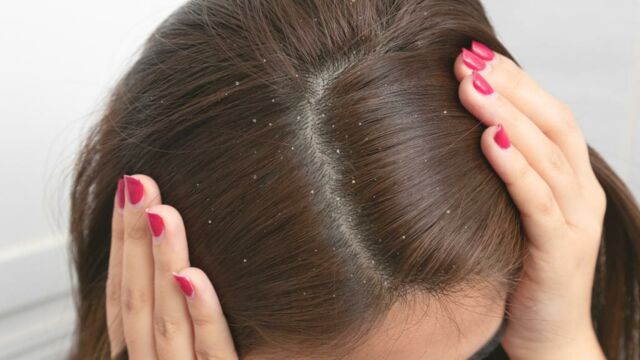Dandruff is one common inconvenience that a huge number of people deal with on a daily basis. For the lucky lot of you who have no idea what dandruff is, it’s a condition in which rapid cell turnover causes dead skin cells to flake off your scalp. Consequently, you may see bits of white or yellow particles peaking through your locks or dropping to your shoulders.
Discover our latest podcast
There are different kinds of dandruff that is caused by differing scalp conditions. As a result, not all types of dandruff can be treated in the same way. So, if you want to get rid of your year-round snowflakes once and for all, you’ll need to identify what kind of dandruff you’re dealing with first.
Dry skin dandruff

This is the most common form of dandruff and it happens when your skin is dried out because you wash it regularly with hot water. Indoor heating during colder months can also dry out your scalp and cause it to flake even more.
Dry skin dandruff is usually small, white, and could be accompanied by itchiness. In the case that the itchiness is too severe, it could mean that you are allergic to your shampoo. Dr. Eva Melegh, consultant dermatologist, tells Mail Online:
Studies show that around 10 per cent of the population suffer from an allergy to a common preservative used in most standard shampoos called MITT (Methylisothiazolinone).
In order to save your scalp, you need to make sure that it’s nourished and moisturised. Use a gentle shampoo to clean your scalp, put on a coconut oil mask to moisturise it, and stick to washing your hair with lukewarm water. Dr. Melegh also suggests using chemical-free and reparative scalp treatments.
Oily skin dandruff

What’s confusing about dandruff is that although it’s often associated with a dry and flaky scalp, people who produce too much oil can also have the same condition. Health experts at Verywell Health explained that this is because of a buildup of sebum. When the sebum clumps together, it irritates the scalp, which then leads to itchy dandruff flakes. These flakes are usually oily and yellow in colour.
To bring your oil production under control, Healthline advises using a dandruff shampoo with salicylic acid.
Fungal dandruff
If you’ve been noticing that you have larger flakes that look slightly waxy, you may have a fungus living on your scalp and it could be feeding on the oils that are produced by the skin and hair. This fungus is called Malassezia globose and it’s predominantly found in people with an oily scalp. As explained by Dr. Melegh, the fungus emits oleic acid which aggravates the skin and causes fungal dandruff. She adds:
Anti-dandruff shampoos typically contain pyrithione zinc, the most common anti-fungal ingredient. However over use of anti-dandruff shampoos can lead to a dry and sensitive scalp and cause different sort or dandruff, so their use should be limited.
There are other skin-related conditions that could also be the cause of your dandruff, including eczema, psoriasis, and sebopsoriasis. In these cases, you should consult your doctor in order to get the right treatment and diagnosis.















